Taxation Law: Carter Pty Ltd - Assessment 2 - University Solution
VerifiedAdded on 2023/03/17
|11
|2813
|71
Homework Assignment
AI Summary
This document presents a comprehensive solution to a Taxation Law assignment focusing on the case of Carter Pty Ltd. The assignment delves into the tax implications of Carter's property transactions, analyzing whether profits from land sales constitute ordinary income or capital gains. It examines the application of relevant tax legislation, including the ITAA 1936 and ITAA 1997, and explores the concepts of isolated transactions and CGT. The analysis extends to the partnership structure of Carter Pty Ltd, addressing the tax liabilities of individual partners Julie and Cameron Carter. Furthermore, the assignment considers the tax treatment of gifts received, specifically addressing whether an antique table received by Julie is considered assessable income. The solution provides a detailed breakdown of the relevant legal principles, case law, and their application to the facts of the case, offering a thorough understanding of the tax issues involved.
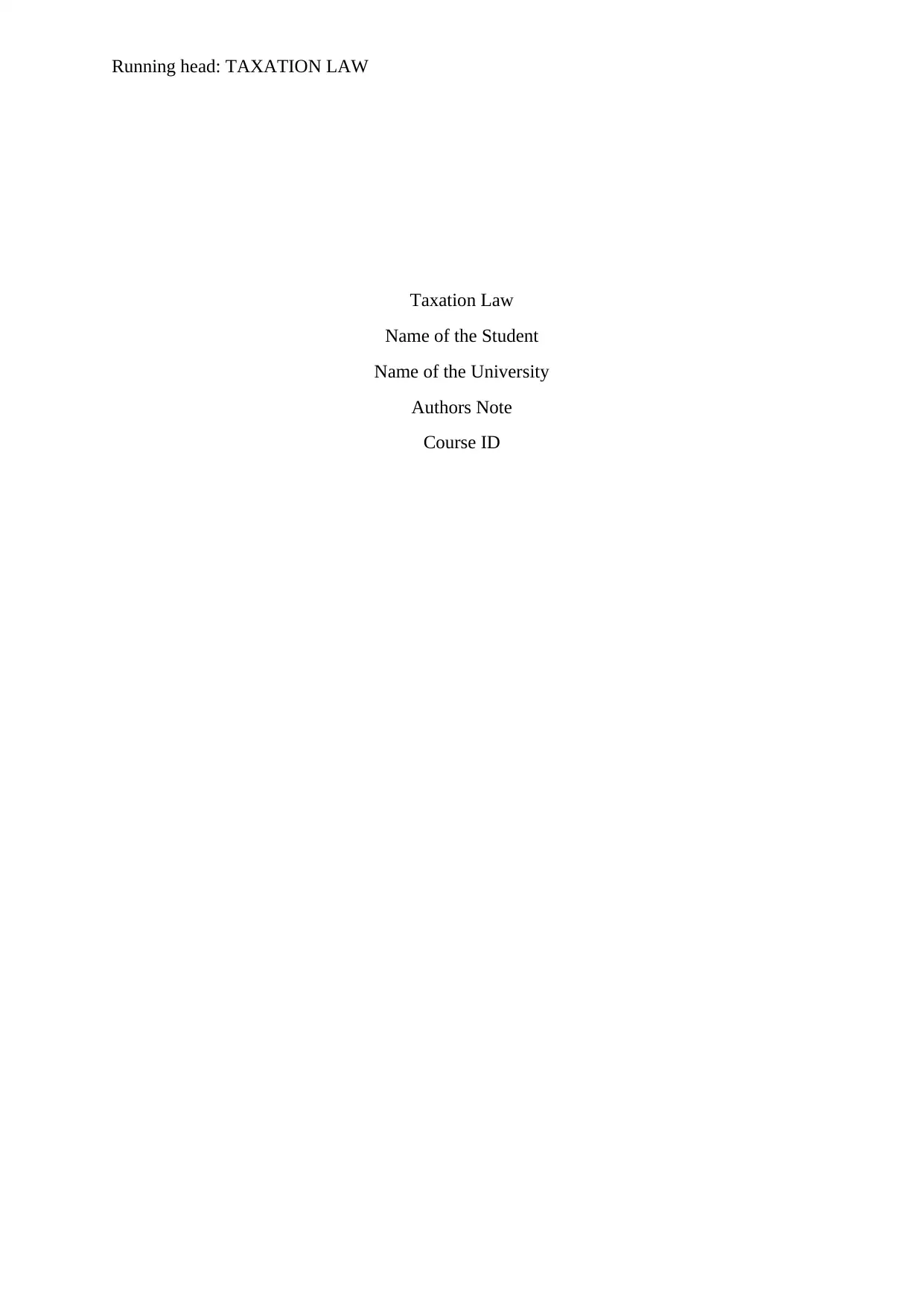
Running head: TAXATION LAW
Taxation Law
Name of the Student
Name of the University
Authors Note
Course ID
Taxation Law
Name of the Student
Name of the University
Authors Note
Course ID
Paraphrase This Document
Need a fresh take? Get an instant paraphrase of this document with our AI Paraphraser

1TAXATION LAW
Table of Contents
Answer to question A:................................................................................................................2
Answer to question B:................................................................................................................5
Answer to question C:................................................................................................................7
References:...............................................................................................................................10
Table of Contents
Answer to question A:................................................................................................................2
Answer to question B:................................................................................................................5
Answer to question C:................................................................................................................7
References:...............................................................................................................................10
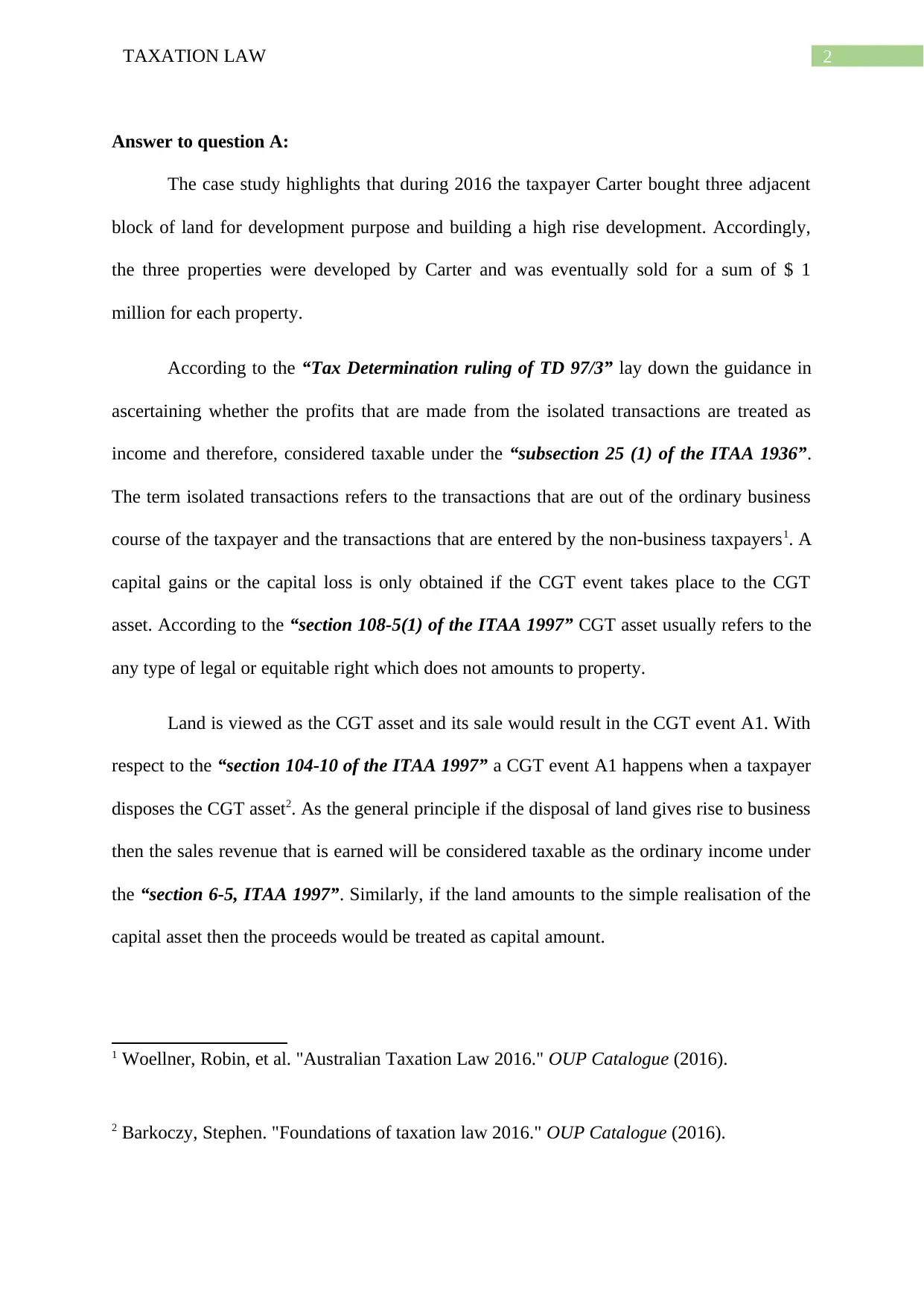
2TAXATION LAW
Answer to question A:
The case study highlights that during 2016 the taxpayer Carter bought three adjacent
block of land for development purpose and building a high rise development. Accordingly,
the three properties were developed by Carter and was eventually sold for a sum of $ 1
million for each property.
According to the “Tax Determination ruling of TD 97/3” lay down the guidance in
ascertaining whether the profits that are made from the isolated transactions are treated as
income and therefore, considered taxable under the “subsection 25 (1) of the ITAA 1936”.
The term isolated transactions refers to the transactions that are out of the ordinary business
course of the taxpayer and the transactions that are entered by the non-business taxpayers1. A
capital gains or the capital loss is only obtained if the CGT event takes place to the CGT
asset. According to the “section 108-5(1) of the ITAA 1997” CGT asset usually refers to the
any type of legal or equitable right which does not amounts to property.
Land is viewed as the CGT asset and its sale would result in the CGT event A1. With
respect to the “section 104-10 of the ITAA 1997” a CGT event A1 happens when a taxpayer
disposes the CGT asset2. As the general principle if the disposal of land gives rise to business
then the sales revenue that is earned will be considered taxable as the ordinary income under
the “section 6-5, ITAA 1997”. Similarly, if the land amounts to the simple realisation of the
capital asset then the proceeds would be treated as capital amount.
1 Woellner, Robin, et al. "Australian Taxation Law 2016." OUP Catalogue (2016).
2 Barkoczy, Stephen. "Foundations of taxation law 2016." OUP Catalogue (2016).
Answer to question A:
The case study highlights that during 2016 the taxpayer Carter bought three adjacent
block of land for development purpose and building a high rise development. Accordingly,
the three properties were developed by Carter and was eventually sold for a sum of $ 1
million for each property.
According to the “Tax Determination ruling of TD 97/3” lay down the guidance in
ascertaining whether the profits that are made from the isolated transactions are treated as
income and therefore, considered taxable under the “subsection 25 (1) of the ITAA 1936”.
The term isolated transactions refers to the transactions that are out of the ordinary business
course of the taxpayer and the transactions that are entered by the non-business taxpayers1. A
capital gains or the capital loss is only obtained if the CGT event takes place to the CGT
asset. According to the “section 108-5(1) of the ITAA 1997” CGT asset usually refers to the
any type of legal or equitable right which does not amounts to property.
Land is viewed as the CGT asset and its sale would result in the CGT event A1. With
respect to the “section 104-10 of the ITAA 1997” a CGT event A1 happens when a taxpayer
disposes the CGT asset2. As the general principle if the disposal of land gives rise to business
then the sales revenue that is earned will be considered taxable as the ordinary income under
the “section 6-5, ITAA 1997”. Similarly, if the land amounts to the simple realisation of the
capital asset then the proceeds would be treated as capital amount.
1 Woellner, Robin, et al. "Australian Taxation Law 2016." OUP Catalogue (2016).
2 Barkoczy, Stephen. "Foundations of taxation law 2016." OUP Catalogue (2016).
⊘ This is a preview!⊘
Do you want full access?
Subscribe today to unlock all pages.

Trusted by 1+ million students worldwide
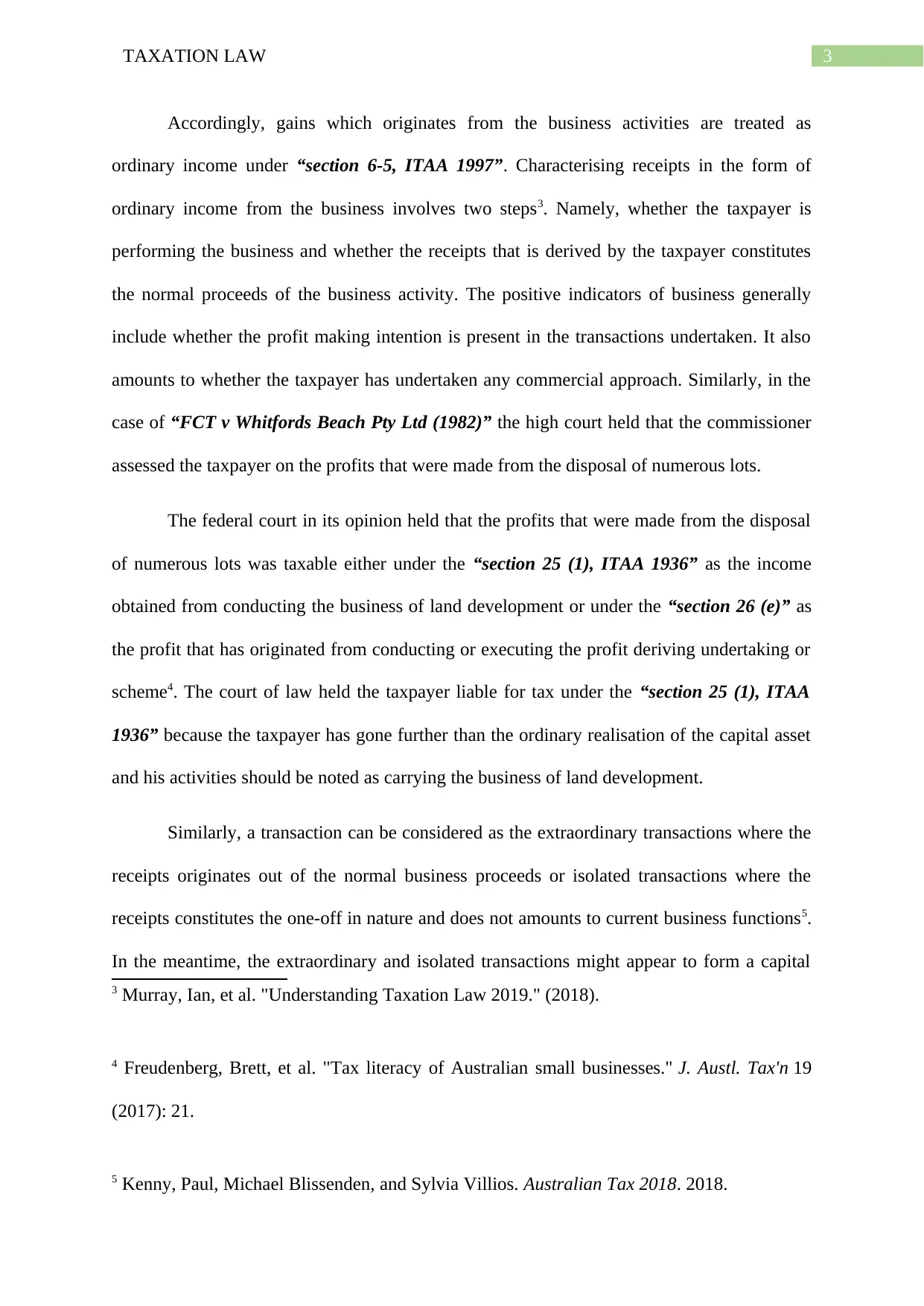
3TAXATION LAW
Accordingly, gains which originates from the business activities are treated as
ordinary income under “section 6-5, ITAA 1997”. Characterising receipts in the form of
ordinary income from the business involves two steps3. Namely, whether the taxpayer is
performing the business and whether the receipts that is derived by the taxpayer constitutes
the normal proceeds of the business activity. The positive indicators of business generally
include whether the profit making intention is present in the transactions undertaken. It also
amounts to whether the taxpayer has undertaken any commercial approach. Similarly, in the
case of “FCT v Whitfords Beach Pty Ltd (1982)” the high court held that the commissioner
assessed the taxpayer on the profits that were made from the disposal of numerous lots.
The federal court in its opinion held that the profits that were made from the disposal
of numerous lots was taxable either under the “section 25 (1), ITAA 1936” as the income
obtained from conducting the business of land development or under the “section 26 (e)” as
the profit that has originated from conducting or executing the profit deriving undertaking or
scheme4. The court of law held the taxpayer liable for tax under the “section 25 (1), ITAA
1936” because the taxpayer has gone further than the ordinary realisation of the capital asset
and his activities should be noted as carrying the business of land development.
Similarly, a transaction can be considered as the extraordinary transactions where the
receipts originates out of the normal business proceeds or isolated transactions where the
receipts constitutes the one-off in nature and does not amounts to current business functions5.
In the meantime, the extraordinary and isolated transactions might appear to form a capital
3 Murray, Ian, et al. "Understanding Taxation Law 2019." (2018).
4 Freudenberg, Brett, et al. "Tax literacy of Australian small businesses." J. Austl. Tax'n 19
(2017): 21.
5 Kenny, Paul, Michael Blissenden, and Sylvia Villios. Australian Tax 2018. 2018.
Accordingly, gains which originates from the business activities are treated as
ordinary income under “section 6-5, ITAA 1997”. Characterising receipts in the form of
ordinary income from the business involves two steps3. Namely, whether the taxpayer is
performing the business and whether the receipts that is derived by the taxpayer constitutes
the normal proceeds of the business activity. The positive indicators of business generally
include whether the profit making intention is present in the transactions undertaken. It also
amounts to whether the taxpayer has undertaken any commercial approach. Similarly, in the
case of “FCT v Whitfords Beach Pty Ltd (1982)” the high court held that the commissioner
assessed the taxpayer on the profits that were made from the disposal of numerous lots.
The federal court in its opinion held that the profits that were made from the disposal
of numerous lots was taxable either under the “section 25 (1), ITAA 1936” as the income
obtained from conducting the business of land development or under the “section 26 (e)” as
the profit that has originated from conducting or executing the profit deriving undertaking or
scheme4. The court of law held the taxpayer liable for tax under the “section 25 (1), ITAA
1936” because the taxpayer has gone further than the ordinary realisation of the capital asset
and his activities should be noted as carrying the business of land development.
Similarly, a transaction can be considered as the extraordinary transactions where the
receipts originates out of the normal business proceeds or isolated transactions where the
receipts constitutes the one-off in nature and does not amounts to current business functions5.
In the meantime, the extraordinary and isolated transactions might appear to form a capital
3 Murray, Ian, et al. "Understanding Taxation Law 2019." (2018).
4 Freudenberg, Brett, et al. "Tax literacy of Australian small businesses." J. Austl. Tax'n 19
(2017): 21.
5 Kenny, Paul, Michael Blissenden, and Sylvia Villios. Australian Tax 2018. 2018.
Paraphrase This Document
Need a fresh take? Get an instant paraphrase of this document with our AI Paraphraser

4TAXATION LAW
characterisation it might be treated as the ordinary income provided that it falls under the
category of business itself.
Sales proceeds that are earned from the extraordinary and isolated transactions will be
treated as the ordinary income if the first or second strand of the “Myer’s” case is applied. As
held in the case of “The Myer Emporium Ltd v FCT (1987)” an extraordinary or isolated
transactions would mean that there was business operations or transaction was commercial in
nature6. It also includes that there was the intention of making profit at the time of entering
the transaction or the profit is made by the taxpayer that are consistent with the original
intention.
As evident in the current situation of Carter the property was solely bought with the
intention of making profit. He carried out the extensive work on the property in order to sell
the property for the best value. With reference to the decision made in “FCT v Whitfords
Beach Pty Ltd (1982)” it can be stated that Carter will be considered taxable for the profits
that is made from the sale of three properties with each for a sum of $1 million7. Accordingly,
the profit that has been made the sale of property exhibited proceeds from the isolated
transaction which carried adequate indicators of the business and should be considered
ordinary income from the business activity.
6 Graetz, Michael J., and Alvin C. Warren. "Integration of corporate and shareholder
taxes." National Tax Journal, Forthcoming (2016): 16-36.
7 Davison, Mark, Ann Monotti, and Leanne Wiseman. Australian intellectual property law.
Cambridge University Press, 2015.
characterisation it might be treated as the ordinary income provided that it falls under the
category of business itself.
Sales proceeds that are earned from the extraordinary and isolated transactions will be
treated as the ordinary income if the first or second strand of the “Myer’s” case is applied. As
held in the case of “The Myer Emporium Ltd v FCT (1987)” an extraordinary or isolated
transactions would mean that there was business operations or transaction was commercial in
nature6. It also includes that there was the intention of making profit at the time of entering
the transaction or the profit is made by the taxpayer that are consistent with the original
intention.
As evident in the current situation of Carter the property was solely bought with the
intention of making profit. He carried out the extensive work on the property in order to sell
the property for the best value. With reference to the decision made in “FCT v Whitfords
Beach Pty Ltd (1982)” it can be stated that Carter will be considered taxable for the profits
that is made from the sale of three properties with each for a sum of $1 million7. Accordingly,
the profit that has been made the sale of property exhibited proceeds from the isolated
transaction which carried adequate indicators of the business and should be considered
ordinary income from the business activity.
6 Graetz, Michael J., and Alvin C. Warren. "Integration of corporate and shareholder
taxes." National Tax Journal, Forthcoming (2016): 16-36.
7 Davison, Mark, Ann Monotti, and Leanne Wiseman. Australian intellectual property law.
Cambridge University Press, 2015.
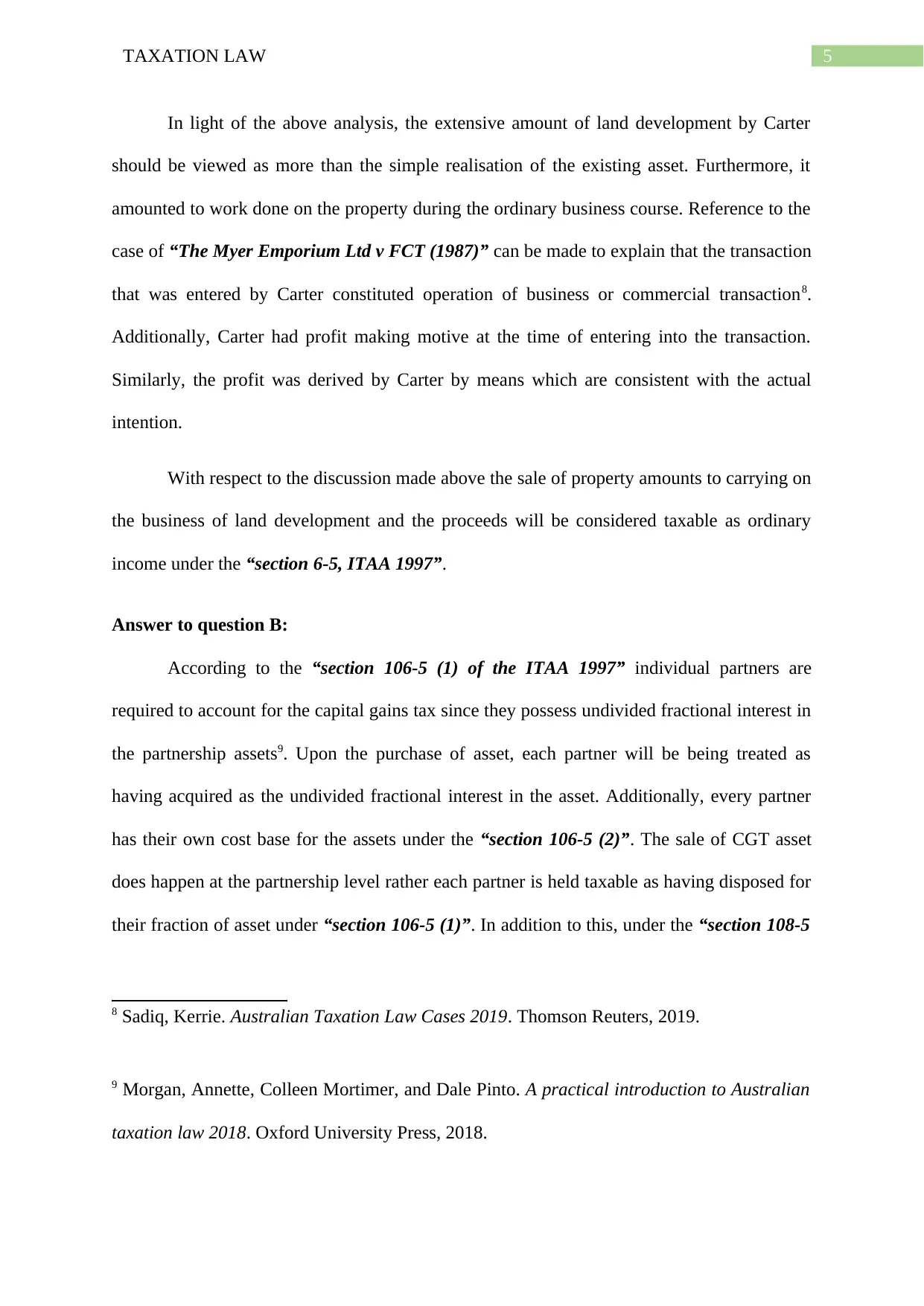
5TAXATION LAW
In light of the above analysis, the extensive amount of land development by Carter
should be viewed as more than the simple realisation of the existing asset. Furthermore, it
amounted to work done on the property during the ordinary business course. Reference to the
case of “The Myer Emporium Ltd v FCT (1987)” can be made to explain that the transaction
that was entered by Carter constituted operation of business or commercial transaction8.
Additionally, Carter had profit making motive at the time of entering into the transaction.
Similarly, the profit was derived by Carter by means which are consistent with the actual
intention.
With respect to the discussion made above the sale of property amounts to carrying on
the business of land development and the proceeds will be considered taxable as ordinary
income under the “section 6-5, ITAA 1997”.
Answer to question B:
According to the “section 106-5 (1) of the ITAA 1997” individual partners are
required to account for the capital gains tax since they possess undivided fractional interest in
the partnership assets9. Upon the purchase of asset, each partner will be being treated as
having acquired as the undivided fractional interest in the asset. Additionally, every partner
has their own cost base for the assets under the “section 106-5 (2)”. The sale of CGT asset
does happen at the partnership level rather each partner is held taxable as having disposed for
their fraction of asset under “section 106-5 (1)”. In addition to this, under the “section 108-5
8 Sadiq, Kerrie. Australian Taxation Law Cases 2019. Thomson Reuters, 2019.
9 Morgan, Annette, Colleen Mortimer, and Dale Pinto. A practical introduction to Australian
taxation law 2018. Oxford University Press, 2018.
In light of the above analysis, the extensive amount of land development by Carter
should be viewed as more than the simple realisation of the existing asset. Furthermore, it
amounted to work done on the property during the ordinary business course. Reference to the
case of “The Myer Emporium Ltd v FCT (1987)” can be made to explain that the transaction
that was entered by Carter constituted operation of business or commercial transaction8.
Additionally, Carter had profit making motive at the time of entering into the transaction.
Similarly, the profit was derived by Carter by means which are consistent with the actual
intention.
With respect to the discussion made above the sale of property amounts to carrying on
the business of land development and the proceeds will be considered taxable as ordinary
income under the “section 6-5, ITAA 1997”.
Answer to question B:
According to the “section 106-5 (1) of the ITAA 1997” individual partners are
required to account for the capital gains tax since they possess undivided fractional interest in
the partnership assets9. Upon the purchase of asset, each partner will be being treated as
having acquired as the undivided fractional interest in the asset. Additionally, every partner
has their own cost base for the assets under the “section 106-5 (2)”. The sale of CGT asset
does happen at the partnership level rather each partner is held taxable as having disposed for
their fraction of asset under “section 106-5 (1)”. In addition to this, under the “section 108-5
8 Sadiq, Kerrie. Australian Taxation Law Cases 2019. Thomson Reuters, 2019.
9 Morgan, Annette, Colleen Mortimer, and Dale Pinto. A practical introduction to Australian
taxation law 2018. Oxford University Press, 2018.
⊘ This is a preview!⊘
Do you want full access?
Subscribe today to unlock all pages.

Trusted by 1+ million students worldwide
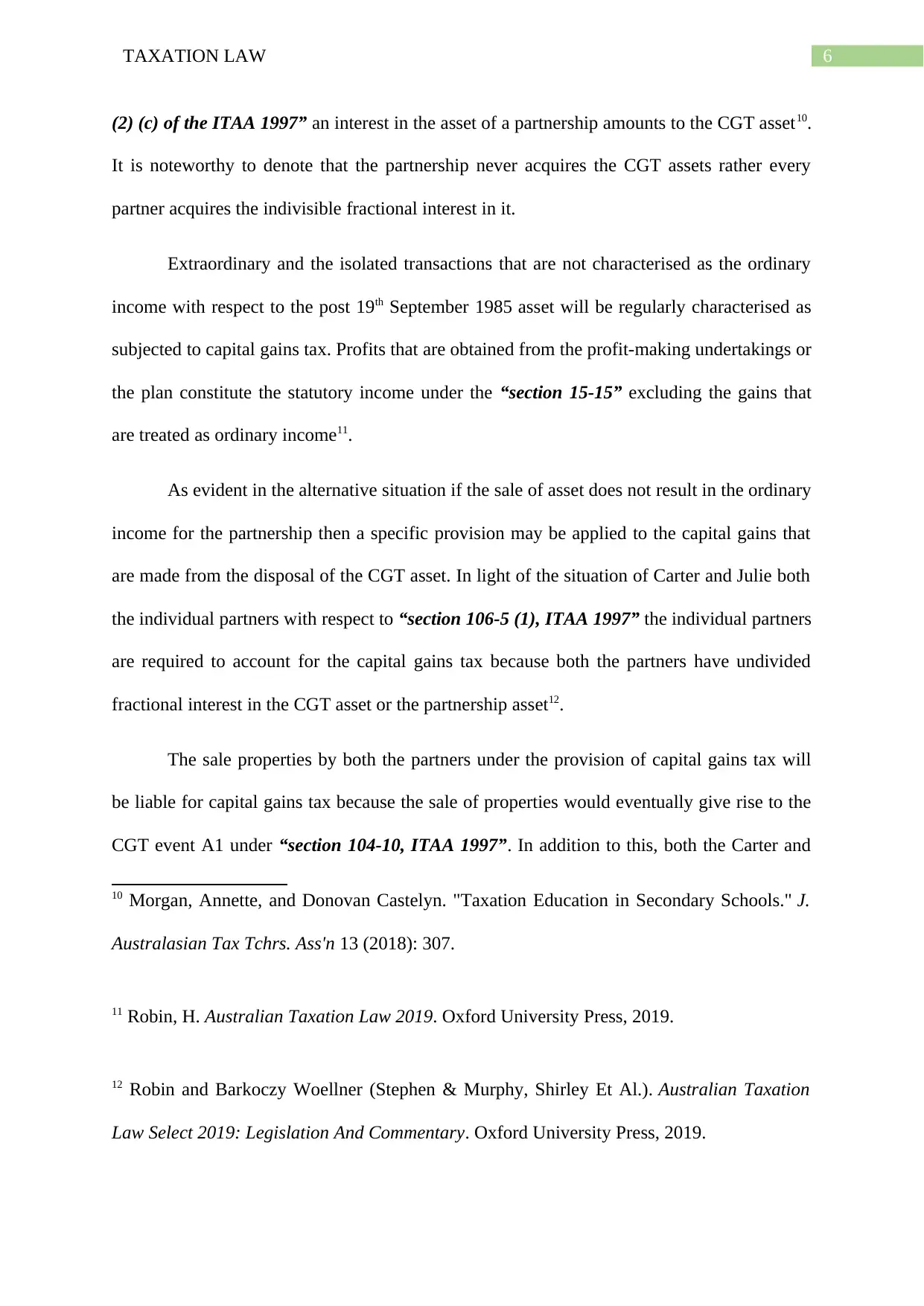
6TAXATION LAW
(2) (c) of the ITAA 1997” an interest in the asset of a partnership amounts to the CGT asset10.
It is noteworthy to denote that the partnership never acquires the CGT assets rather every
partner acquires the indivisible fractional interest in it.
Extraordinary and the isolated transactions that are not characterised as the ordinary
income with respect to the post 19th September 1985 asset will be regularly characterised as
subjected to capital gains tax. Profits that are obtained from the profit-making undertakings or
the plan constitute the statutory income under the “section 15-15” excluding the gains that
are treated as ordinary income11.
As evident in the alternative situation if the sale of asset does not result in the ordinary
income for the partnership then a specific provision may be applied to the capital gains that
are made from the disposal of the CGT asset. In light of the situation of Carter and Julie both
the individual partners with respect to “section 106-5 (1), ITAA 1997” the individual partners
are required to account for the capital gains tax because both the partners have undivided
fractional interest in the CGT asset or the partnership asset12.
The sale properties by both the partners under the provision of capital gains tax will
be liable for capital gains tax because the sale of properties would eventually give rise to the
CGT event A1 under “section 104-10, ITAA 1997”. In addition to this, both the Carter and
10 Morgan, Annette, and Donovan Castelyn. "Taxation Education in Secondary Schools." J.
Australasian Tax Tchrs. Ass'n 13 (2018): 307.
11 Robin, H. Australian Taxation Law 2019. Oxford University Press, 2019.
12 Robin and Barkoczy Woellner (Stephen & Murphy, Shirley Et Al.). Australian Taxation
Law Select 2019: Legislation And Commentary. Oxford University Press, 2019.
(2) (c) of the ITAA 1997” an interest in the asset of a partnership amounts to the CGT asset10.
It is noteworthy to denote that the partnership never acquires the CGT assets rather every
partner acquires the indivisible fractional interest in it.
Extraordinary and the isolated transactions that are not characterised as the ordinary
income with respect to the post 19th September 1985 asset will be regularly characterised as
subjected to capital gains tax. Profits that are obtained from the profit-making undertakings or
the plan constitute the statutory income under the “section 15-15” excluding the gains that
are treated as ordinary income11.
As evident in the alternative situation if the sale of asset does not result in the ordinary
income for the partnership then a specific provision may be applied to the capital gains that
are made from the disposal of the CGT asset. In light of the situation of Carter and Julie both
the individual partners with respect to “section 106-5 (1), ITAA 1997” the individual partners
are required to account for the capital gains tax because both the partners have undivided
fractional interest in the CGT asset or the partnership asset12.
The sale properties by both the partners under the provision of capital gains tax will
be liable for capital gains tax because the sale of properties would eventually give rise to the
CGT event A1 under “section 104-10, ITAA 1997”. In addition to this, both the Carter and
10 Morgan, Annette, and Donovan Castelyn. "Taxation Education in Secondary Schools." J.
Australasian Tax Tchrs. Ass'n 13 (2018): 307.
11 Robin, H. Australian Taxation Law 2019. Oxford University Press, 2019.
12 Robin and Barkoczy Woellner (Stephen & Murphy, Shirley Et Al.). Australian Taxation
Law Select 2019: Legislation And Commentary. Oxford University Press, 2019.
Paraphrase This Document
Need a fresh take? Get an instant paraphrase of this document with our AI Paraphraser
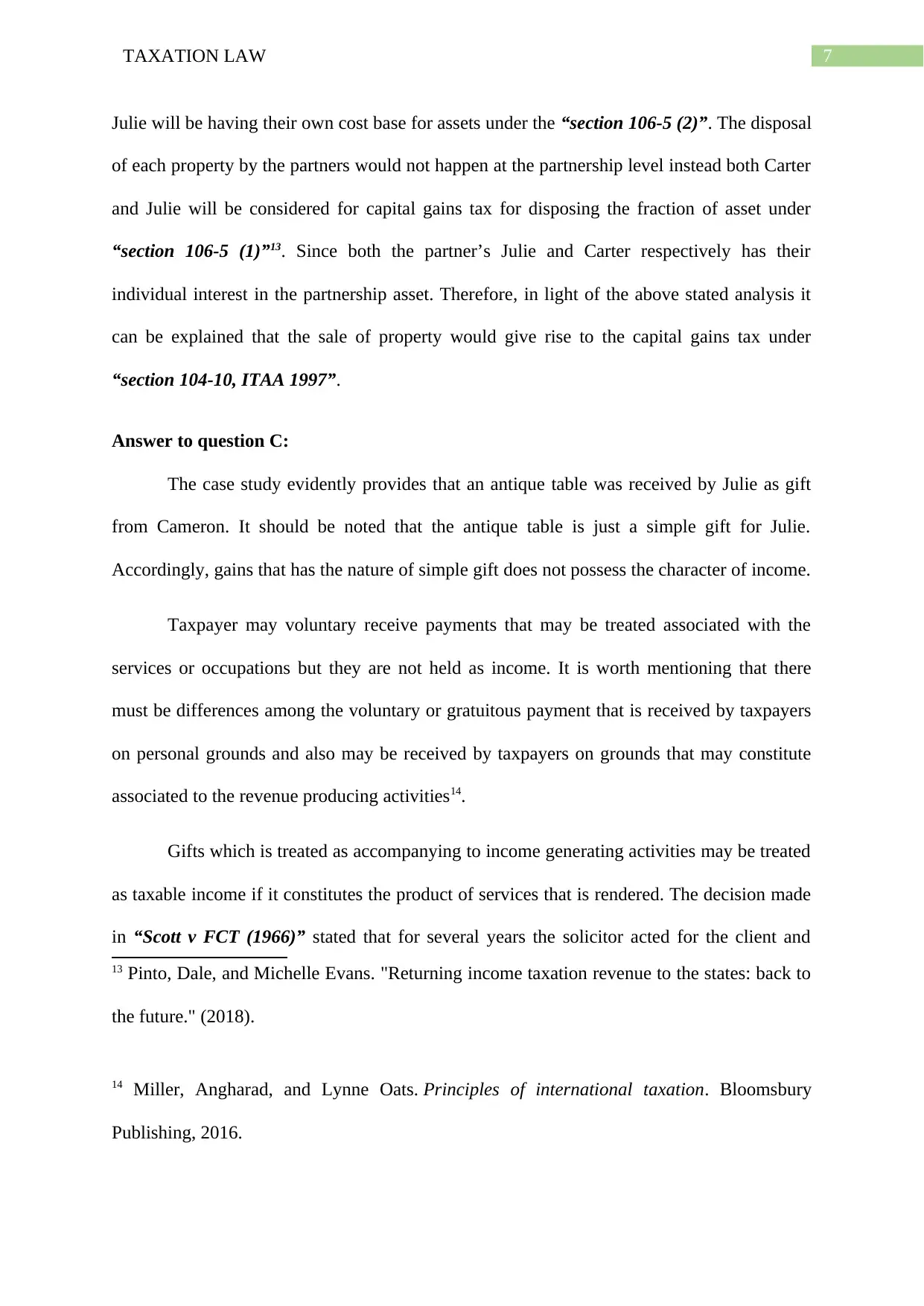
7TAXATION LAW
Julie will be having their own cost base for assets under the “section 106-5 (2)”. The disposal
of each property by the partners would not happen at the partnership level instead both Carter
and Julie will be considered for capital gains tax for disposing the fraction of asset under
“section 106-5 (1)”13. Since both the partner’s Julie and Carter respectively has their
individual interest in the partnership asset. Therefore, in light of the above stated analysis it
can be explained that the sale of property would give rise to the capital gains tax under
“section 104-10, ITAA 1997”.
Answer to question C:
The case study evidently provides that an antique table was received by Julie as gift
from Cameron. It should be noted that the antique table is just a simple gift for Julie.
Accordingly, gains that has the nature of simple gift does not possess the character of income.
Taxpayer may voluntary receive payments that may be treated associated with the
services or occupations but they are not held as income. It is worth mentioning that there
must be differences among the voluntary or gratuitous payment that is received by taxpayers
on personal grounds and also may be received by taxpayers on grounds that may constitute
associated to the revenue producing activities14.
Gifts which is treated as accompanying to income generating activities may be treated
as taxable income if it constitutes the product of services that is rendered. The decision made
in “Scott v FCT (1966)” stated that for several years the solicitor acted for the client and
13 Pinto, Dale, and Michelle Evans. "Returning income taxation revenue to the states: back to
the future." (2018).
14 Miller, Angharad, and Lynne Oats. Principles of international taxation. Bloomsbury
Publishing, 2016.
Julie will be having their own cost base for assets under the “section 106-5 (2)”. The disposal
of each property by the partners would not happen at the partnership level instead both Carter
and Julie will be considered for capital gains tax for disposing the fraction of asset under
“section 106-5 (1)”13. Since both the partner’s Julie and Carter respectively has their
individual interest in the partnership asset. Therefore, in light of the above stated analysis it
can be explained that the sale of property would give rise to the capital gains tax under
“section 104-10, ITAA 1997”.
Answer to question C:
The case study evidently provides that an antique table was received by Julie as gift
from Cameron. It should be noted that the antique table is just a simple gift for Julie.
Accordingly, gains that has the nature of simple gift does not possess the character of income.
Taxpayer may voluntary receive payments that may be treated associated with the
services or occupations but they are not held as income. It is worth mentioning that there
must be differences among the voluntary or gratuitous payment that is received by taxpayers
on personal grounds and also may be received by taxpayers on grounds that may constitute
associated to the revenue producing activities14.
Gifts which is treated as accompanying to income generating activities may be treated
as taxable income if it constitutes the product of services that is rendered. The decision made
in “Scott v FCT (1966)” stated that for several years the solicitor acted for the client and
13 Pinto, Dale, and Michelle Evans. "Returning income taxation revenue to the states: back to
the future." (2018).
14 Miller, Angharad, and Lynne Oats. Principles of international taxation. Bloomsbury
Publishing, 2016.
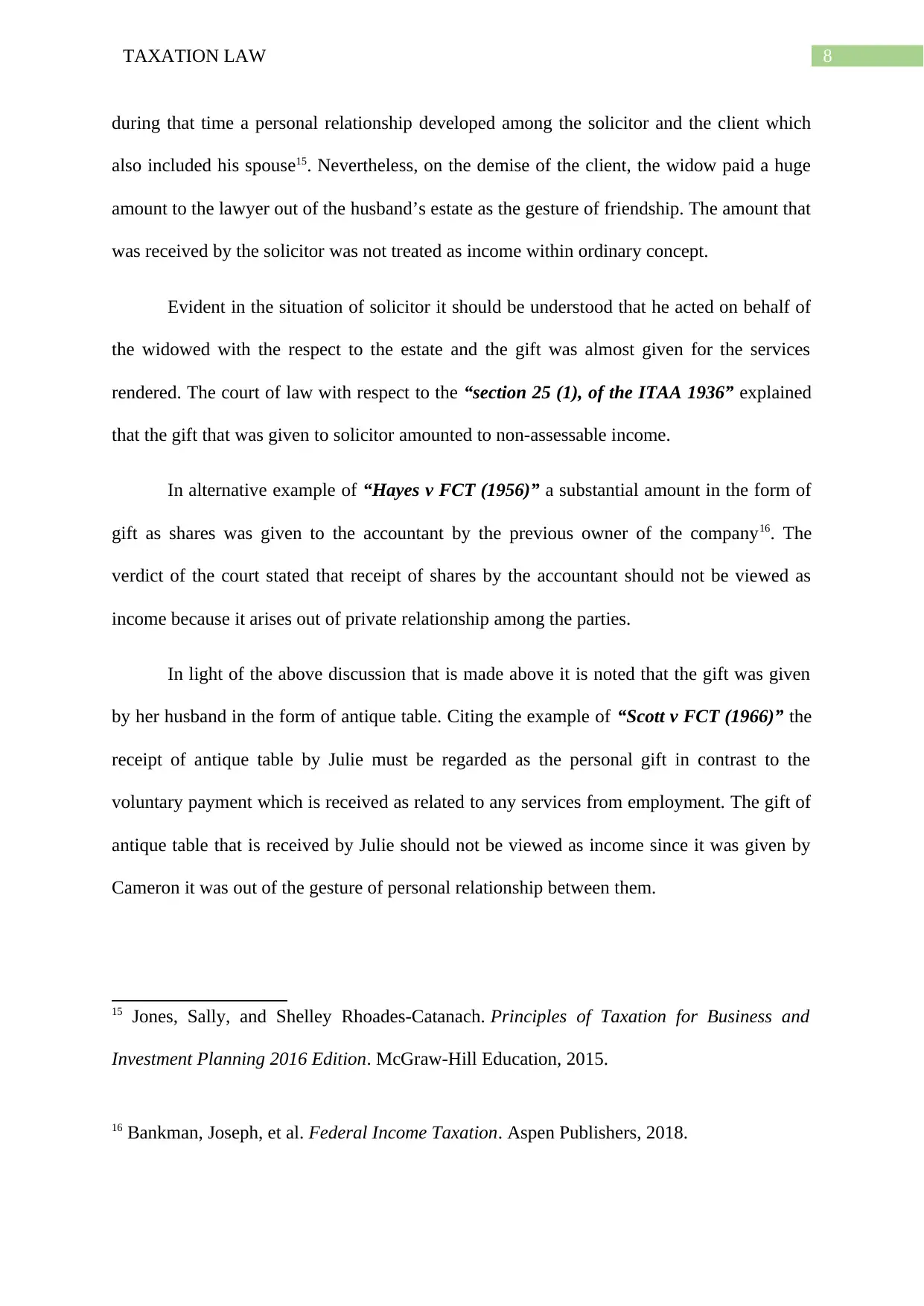
8TAXATION LAW
during that time a personal relationship developed among the solicitor and the client which
also included his spouse15. Nevertheless, on the demise of the client, the widow paid a huge
amount to the lawyer out of the husband’s estate as the gesture of friendship. The amount that
was received by the solicitor was not treated as income within ordinary concept.
Evident in the situation of solicitor it should be understood that he acted on behalf of
the widowed with the respect to the estate and the gift was almost given for the services
rendered. The court of law with respect to the “section 25 (1), of the ITAA 1936” explained
that the gift that was given to solicitor amounted to non-assessable income.
In alternative example of “Hayes v FCT (1956)” a substantial amount in the form of
gift as shares was given to the accountant by the previous owner of the company16. The
verdict of the court stated that receipt of shares by the accountant should not be viewed as
income because it arises out of private relationship among the parties.
In light of the above discussion that is made above it is noted that the gift was given
by her husband in the form of antique table. Citing the example of “Scott v FCT (1966)” the
receipt of antique table by Julie must be regarded as the personal gift in contrast to the
voluntary payment which is received as related to any services from employment. The gift of
antique table that is received by Julie should not be viewed as income since it was given by
Cameron it was out of the gesture of personal relationship between them.
15 Jones, Sally, and Shelley Rhoades-Catanach. Principles of Taxation for Business and
Investment Planning 2016 Edition. McGraw-Hill Education, 2015.
16 Bankman, Joseph, et al. Federal Income Taxation. Aspen Publishers, 2018.
during that time a personal relationship developed among the solicitor and the client which
also included his spouse15. Nevertheless, on the demise of the client, the widow paid a huge
amount to the lawyer out of the husband’s estate as the gesture of friendship. The amount that
was received by the solicitor was not treated as income within ordinary concept.
Evident in the situation of solicitor it should be understood that he acted on behalf of
the widowed with the respect to the estate and the gift was almost given for the services
rendered. The court of law with respect to the “section 25 (1), of the ITAA 1936” explained
that the gift that was given to solicitor amounted to non-assessable income.
In alternative example of “Hayes v FCT (1956)” a substantial amount in the form of
gift as shares was given to the accountant by the previous owner of the company16. The
verdict of the court stated that receipt of shares by the accountant should not be viewed as
income because it arises out of private relationship among the parties.
In light of the above discussion that is made above it is noted that the gift was given
by her husband in the form of antique table. Citing the example of “Scott v FCT (1966)” the
receipt of antique table by Julie must be regarded as the personal gift in contrast to the
voluntary payment which is received as related to any services from employment. The gift of
antique table that is received by Julie should not be viewed as income since it was given by
Cameron it was out of the gesture of personal relationship between them.
15 Jones, Sally, and Shelley Rhoades-Catanach. Principles of Taxation for Business and
Investment Planning 2016 Edition. McGraw-Hill Education, 2015.
16 Bankman, Joseph, et al. Federal Income Taxation. Aspen Publishers, 2018.
⊘ This is a preview!⊘
Do you want full access?
Subscribe today to unlock all pages.

Trusted by 1+ million students worldwide

9TAXATION LAW
References:
Bankman, Joseph, et al. Federal Income Taxation. Aspen Publishers, 2018.
Barkoczy, Stephen. "Foundations of taxation law 2016." OUP Catalogue (2016).
Davison, Mark, Ann Monotti, and Leanne Wiseman. Australian intellectual property law.
Cambridge University Press, 2015.
Freudenberg, Brett, et al. "Tax literacy of Australian small businesses." J. Austl. Tax'n 19
(2017): 21.
Graetz, Michael J., and Alvin C. Warren. "Integration of corporate and shareholder
taxes." National Tax Journal, Forthcoming (2016): 16-36.
Jones, Sally, and Shelley Rhoades-Catanach. Principles of Taxation for Business and
Investment Planning 2016 Edition. McGraw-Hill Education, 2015.
Kenny, Paul, Michael Blissenden, and Sylvia Villios. Australian Tax 2018. 2018.
Miller, Angharad, and Lynne Oats. Principles of international taxation. Bloomsbury
Publishing, 2016.
Morgan, Annette, and Donovan Castelyn. "Taxation Education in Secondary Schools." J.
Australasian Tax Tchrs. Ass'n 13 (2018): 307.
Morgan, Annette, Colleen Mortimer, and Dale Pinto. A practical introduction to Australian
taxation law 2018. Oxford University Press, 2018.
Murray, Ian, et al. "Understanding Taxation Law 2019." (2018).
Pinto, Dale, and Michelle Evans. "Returning income taxation revenue to the states: back to
the future." (2018).
References:
Bankman, Joseph, et al. Federal Income Taxation. Aspen Publishers, 2018.
Barkoczy, Stephen. "Foundations of taxation law 2016." OUP Catalogue (2016).
Davison, Mark, Ann Monotti, and Leanne Wiseman. Australian intellectual property law.
Cambridge University Press, 2015.
Freudenberg, Brett, et al. "Tax literacy of Australian small businesses." J. Austl. Tax'n 19
(2017): 21.
Graetz, Michael J., and Alvin C. Warren. "Integration of corporate and shareholder
taxes." National Tax Journal, Forthcoming (2016): 16-36.
Jones, Sally, and Shelley Rhoades-Catanach. Principles of Taxation for Business and
Investment Planning 2016 Edition. McGraw-Hill Education, 2015.
Kenny, Paul, Michael Blissenden, and Sylvia Villios. Australian Tax 2018. 2018.
Miller, Angharad, and Lynne Oats. Principles of international taxation. Bloomsbury
Publishing, 2016.
Morgan, Annette, and Donovan Castelyn. "Taxation Education in Secondary Schools." J.
Australasian Tax Tchrs. Ass'n 13 (2018): 307.
Morgan, Annette, Colleen Mortimer, and Dale Pinto. A practical introduction to Australian
taxation law 2018. Oxford University Press, 2018.
Murray, Ian, et al. "Understanding Taxation Law 2019." (2018).
Pinto, Dale, and Michelle Evans. "Returning income taxation revenue to the states: back to
the future." (2018).
Paraphrase This Document
Need a fresh take? Get an instant paraphrase of this document with our AI Paraphraser

10TAXATION LAW
Robin and Barkoczy Woellner (Stephen & Murphy, Shirley Et Al.). Australian Taxation Law
Select 2019: Legislation And Commentary. Oxford University Press, 2019.
Robin, H. Australian Taxation Law 2019. Oxford University Press, 2019.
Sadiq, Kerrie. Australian Taxation Law Cases 2019. Thomson Reuters, 2019.
Woellner, Robin, et al. "Australian Taxation Law 2016." OUP Catalogue (2016).
Robin and Barkoczy Woellner (Stephen & Murphy, Shirley Et Al.). Australian Taxation Law
Select 2019: Legislation And Commentary. Oxford University Press, 2019.
Robin, H. Australian Taxation Law 2019. Oxford University Press, 2019.
Sadiq, Kerrie. Australian Taxation Law Cases 2019. Thomson Reuters, 2019.
Woellner, Robin, et al. "Australian Taxation Law 2016." OUP Catalogue (2016).
1 out of 11
Related Documents
Your All-in-One AI-Powered Toolkit for Academic Success.
+13062052269
info@desklib.com
Available 24*7 on WhatsApp / Email
![[object Object]](/_next/static/media/star-bottom.7253800d.svg)
Unlock your academic potential
Copyright © 2020–2025 A2Z Services. All Rights Reserved. Developed and managed by ZUCOL.





